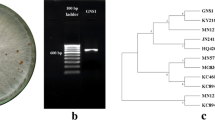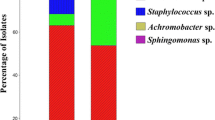Abstract
Bacterial wilt caused by Ralstonia solanacearum is a serious threat for agricultural production in China. Eight soil bacterial isolates with activity against R. solanacearum TM15 (biovar 3) were tested in this study for their in vitro activity towards ten genetically diverse R. solanacearum isolates from China. The results indicated that each antagonist showed remarkable differences in its ability to in vitro antagonize the ten different R. solanacearum strains. Strain XY21 (based on 16S rRNA gene sequencing affiliated to Serratia) was selected for further studies based on its in vitro antagonistic activity and its excellent rhizocompetence on tomato plants. Under greenhouse conditions XY21 mediated biocontrol of tomato wilt caused by seven different R. solanacearum strains ranged from 19 to 70 %. The establishment of XY21 and its effects on the bacterial community in the tomato rhizosphere were monitored by denaturing gradient gel electrophoresis of 16S rRNA gene fragments PCR-amplified from total community DNA. A positive correlation of the in vitro antagonistic activities of XY21 and the actual biocontrol efficacies towards seven genetically different R. solanacearum strains was found and further confirmed by the efficacy of XY21 in controlling bacterial wilt under field conditions.



Similar content being viewed by others
References
Ahmed Idris H, Labuschagne N, Korsten L (2008) Suppression of Pythium ultimum root rot of sorghum by rhizobacterial isolates from Ethiopia and South Africa. Biol Control 45:72–84. doi:10.1016/j.biocontrol.2007.11.004
Berg G, Eberl L, Hartmann A (2005) The rhizosphere as a reservoir for opportunistic human pathogenic bacteria. Environ Microbiol 7:1673–1685. doi:10.1111/j.1462-2920.2005.00891.x
Bhatti KH, Ahmed N, Shah A, Iqbal M, Iqbal T, Wu J (2011) Transgenic tobacco with rice zinc-finger gene OsLOL2 exhibits an enhanced resistance against bacterial-wilt. Australasian Plant Pathol. doi:10.1007/s13313-010-0022-x
Bull CT, Weller DM, Thomashow LS (1991) Relationship between root colonization and suppression of Gaeumannomyces graminis var. tritici by Pseudomonas fluorescens strain 2–79. Phytopathology 81:954–959. doi:10.1094/Phyto-81-954
Chen Y, Tang C, Liu A, Peng R, Li X, He Z (2008) Control effects of four pesticides on tobacco bacterial wilt. Hunan Agric Sci 4:93–95
Costa R, Gomes NCM, Peixoto R, Rumjanek N, Berg G, Mendonça-Hagler L, Smalla K (2006) Diversity and antagonistic potential of Pseudomonas spp. in the rhizosphere of maize grown in a subtropical organic farm. Soil Biol Biochem 38:2434–2447. doi:10.1016/j.soilbio.2006.03.003
Diogo RVC, Wydra K (2007) Silicon-induced basal resistance in tomato against Ralstonia solanacearum is related to modification of pectic cell wall polysaccharide structure. Physiol Mol Plant Pathol 70:120–129. doi:10.1016/j.pmpp.2007.07.008
Dong C, Zeng X, Liu Q (1999) Biological control of tomato bacterial wilt with avirulent bacteriocinogenic strain of Ralstonia solanacearum. J Sci China Agric Univ 20:1–4. doi:1001-411X.0.1999-04-000
El Albyad MS, el Sayed MA, el Shanshoury AR (1996) Effect of culture conditions on the antimicrobial activities of UV-mutants of Streptomyces corchorusii and S. spiroverticillatus against bean and banana wilt pathogens. Microbiol Res 151:201–211
Elphinstone JG (2005) The current bacterial wilt situation: a global overview. In: Allen C, Prior P, Hayward AC (ed) Bacterial Wilt Disease and the Ralstonia solanacearum species complex. APS press, pp 9–28
Garbeva P, van Veen JA, van Elsas JD (2003) Predominant Bacillus spp. in agricultural soil under different management regimes detected via PCR-DGGE. Microb Ecol 45:302–316. doi:10.1007/s00248-002-2034-8
Gomes NCM, Kosheleva IA, Abraham WR, Smalla K (2005) Effects of the inoculant strain Pseudomonas putida KT2442 (pNF142) and of naphthalene contamination on the soil bacterial community. FEMS Microbiol Ecol 54:21–33. doi:10.1016/j.femsec.2005.02.005
Götz M, Gomes NCM, Dratwinski A, Costa R, Berg G, Peixoto R, Mendonça-Hagler L, Smalla K (2006) Survival of gfp-tagged antagonistic bacteria in the rhizosphere of tomato plants and their effects on the indigenous bacterial community. FEMS Microbiol Ecol 56:207–218. doi:10.1111/j.1574-6941.2006.00093.x
Guo JH, Guo YH, Zhang LX, Qi HY, Fang ZD (2001) Screening for biocontrol agents against cayenne pepper bacterial wilt. China J Biol Control 17:101–106
Guo JH, Qi HY, Guo YH, Ge H, Gong LY, Zhang LX, Sun PH (2004) Biocontrol of tomato wilt by plant growth-promoting rhizobacteria. Biol Control 29:66–72. doi:10.1016/S1049-9644(03)00124-5
Hameeda B, Harinib G, Rupela OP, Wani SP, Reddy G (2008) Growth promotion of maize by phosphate-solubilizing bacteria isolated from composts and macrofauna. Microbiol Res 163:234–242. doi:10.1016/j.micres.2006.05.009
Hayward AC (1994) Systematics and phylogeny of Pseudomonas solanacearum and related bacteria. In: Hayward AC, Hartman GL (eds) Bacterial wilt: the disease and its causative agent, Pseudomonas solanacearum. CAB International, Wallingford, pp 123–135
He LY, Kang YW (1990) Induced resistance of peanut produced by avirulent strains of Pseudomonas solanacearum and fluorescent Pseudomonad. J Plant Prot 17:113–116. doi:ZWBF.0.1990-02-004
He LY, Sequeira L, Kelman A (1983) Characteristics of strains of Pseudomonas solanacearum from China. Plant Dis 67:1356–1361. doi:10.1094/PD-67-1357
Heuer H, Krsek M, Smalla K, Wellington EMH (1997) Analysis of actinomycete communities by specific amplification of 16S rDNA and gel electrophoretic separation in denaturing gradients. Appl Environ Microbiol 63:3233–3241
Heuer H, Wieland J, Schönfeld J, Schönwälder A, Gomes NCM, Smalla K (2001) Bacterial community profiling using DGGE or TGGE analysis. In: Rouchelle P (ed) Environmental molecular microbiology: protocols and applications. Horizon Scientific Press, Wymondham, pp 177–190
Heuer H, Yin YN, Xue QY, Smalla K, Guo JH (2007) Repeat domain diversity of avrBs3-like genes in Ralstonia solanacearum strains and association with host preferences in the Field. Appl Environ Microbiol 73:4379–4384. doi:10.1128/AEM.00367-07
Horrita M, Tsuchiya K (2001) Genetic diversity of Japanese strains of Ralstonia solanacearum. Phytopathology 91:399–407. doi:10.1094/PHYTO.2001.91.4.399
Hu HQ, Li XS, He H (2010) Characterization of an antimicrobial material from a newly isolated Bacillus amyloliquefaciens from mangrove for biocontrol of Capsicum bacterial wilt. Biol Control 54:359–365. doi:10.1016/j.biocontrol.2010.06.015
Kang Y, Mao G, Lu C, He L (1995) Biological control of bacterial wilt of tomato by extracellular protein defective mutant of Pseudomonas solanacearum. Acta Phytopathol Sin 22:287–288
Kempe J, Sequeira L (1983) Biological control of baterial wilt of potatoes: attempts to induce resistance by treating tubes with bacteria. Plant Dis 67:499–501
Kobayashi DY, Guglielmoni M, Clarke BB (1995) Isolation of the chitinolytic bacteria Xanthomonas maltophilia and Serratia marcescens as biological control agents for summer patch disease of turfgrass. Soil Biol Biochem 27:1479–1487. doi:10.1016/0038-0717(95)00062-J
Lemessa F, Zeller W (2007) Screening rhizobacteria for biological control of Ralstonia solanacearum in Ethiopia. Biol Control 42:336–344. doi:10.1016/j.biocontrol.2007.05.014
Li JH, Wang ET, Chen WF, Chen WX (2008) Genetic diversity and potential for promotion of plant growth detected in nodule endophytic bacteria of soybean grown in Heilongjiang province of China. Soil Biol Biochem 40:238–246. doi:10.1016/j.soilbio.2007.08.014
Milling A, Smalla K, Maidl FX, Schloter M, Munch JC (2004) Effects of transgenic potatoes with an altered starch composition on the diversity of soil and rhizosphere bacteria and fungi. Plant Soil 266:23–39
Müller H, Berg G (2008) Impact of formulation procedures on the effect of the biocontrol agent Serratia plymuthica HRO-C48 on Verticillium wilt in oilseed rape. BioControl 53:905–916. doi:10.1007/s10526-007-9111-3
Nejad P, Johnson PA (2000) Endophytic bacteria induce growth promotion and wilt disease suppression in oilseed rape and tomato. Biol Control 18:208–215. doi:10.1006/bcon.2000.0837
Raaijmakers JM, Leeman M, van Oorschot MMP, van der Sluis I, Schippers B, Bakker PAHM (1995) Dose–response relationships in biological control of Fusarium wilt of radish by Pseudomonas spp. Phytopathology 85:1075–1081. doi:10.1094/Phyto-85-1075
Raaijmakers JM, Bonsall RE, Weller DM (1999) Effect of population density of Pseudomonas fluorescens on production of 2,4-diacetylphloroglucinol in the rhizosphere of wheat. Phytopathology 89:470–475. doi:10.1094/PHYTO.1999.89.6.470
Rademaker JLW, DeBruijn FJ (1997) Characterization and classification of microbes by rep-PCR genomic fingerprinting and computer assisted pattern analysis. In: Gaetano-Anolles G (ed) DNA markers: protocols, applications and overviews. Wiley & Sons, New York, pp 151–171
Remenant B, Coupat-Goutaland B, Guido A, Cellier G, Wicker E, Allen C, Fegan M (2010) Genomes of three tomato pathogens within the Ralstonia solanacearum species complex reveal significant evolutionary divergence. BMC Genomics 11:379. doi:10.1186/1471-2164-11-379
Roberts DP, McKenna LF, Lakshman DK, Meyer SLF, Kong H, de Souza JT, Lydon J, Baker CJ, Buyer JS, Chung S (2007) Suppression of damping-off of cucumber caused by Pythium ultimum with live cells and extracts of Serratia marcescens N4-5. Soil Biol Biochem 39:2275–2288. doi:10.1016/j.soilbio.2007.03.029
Saddler GS (2005) Management of bacterial wilt disease. In: Allen C, Prior P, Hayward AC (ed) Bacterial Wilt Disease and the Ralstonia solanacearum Species Complex, APS press, pp 121–132
Scherwinski K, Wolf A, Berg G (2007) Assessing the risk of biological control agents on the indigenous microbial communities: Serratia plymuthica HRO-C48 and Streptomyces sp. HRO-71 as model bacteria. Biocontrol 52:87–112. doi:10.1007/s10526-006-9006-8
Silveira EB, Da R, de Mariano LR, Michereff SJ (1995) Antagonism of Bacillus spp. against Pseudomonas solanacearum and effect on tomato seedling growth. Fitopatol Bras 20:605–612
Sisson VA (1999) Registration of “Oxford 207” tobacco. Crop Sci 39:292
Sun S, Wei AM, Wu HX, Wang J (2004) Advances in research on chemical and biological control of plant bacterial wilt. Jiangxi Plant Prot 27:157–162
Thammakijjawat P, Thaveechai N, Kositratana W, Chunwongse J, Frederick RD, Schaad NW (2004) Genetic analysis of Ralstonia solanacearum strains from different hosts in Thailand using PCR-Restriction Fragment Length Polymorphism. Kasetsart J (Nat Sci) 35:397–408
Thaning C, Welch CJ, Borowicz JJ, Hedman R, Gerhardson B (2001) Suppression of Sclerotinia sclerotiorum apothecial formation by the soil bacterium Serratia plymuthica: identification of a chlorinated macrolide as one of the causal agents. Soil Biol Biochem 33:1817–1826. doi:10.1016/S0038-0717(01)00109-2
Thurston HD (1976) Resistance to bacterial wilt (Pseudomonas solanacearum). In: Sequeira L, Kelman A (eds) Proceedings of the first International Planning conferences and workshop on the ecology and control of bacterial wilt caused by Pseudomonas solanacearum. Raleigh, North Carolina, NCSU, pp 58–62
Wang JF, Berke T (1997) Source of resistance to bacterial wilt in Capsicum annuum. Capsicum and eggplant newsletter 16: 91–93
Weisburg WG, Barns SM, Pelletier DA, Lane DJ (1991) 16S ribosomal DNA amplification for phylogenetic study. J Bacteriol 173:697–703
Xue QY, Yin YN, Yang W, Heuer H, Prior P, Guo JH, Smalla K (2011) Genetic diversity of Ralstonia solanacearum strains from China assessed by PCR-based fingerprints to unravel host plant- and site-dependent distribution patterns. FEMS Microbiol Ecol 75:507–519. doi:10.1111/j.1574-6941.2010.01026.x
Yabuuchi E, Kosako Y, Yano I, Hotta H, Nishiuchi Y (1995) Transfer of two Burkholderia and an Alcaligenes species to Ralstonia General Nov: Proposal of Ralstonia pickettii (Ralston, Palleroni and Doudoroff 1973) comb. Nov, Ralstonia solanacearum (Smith 1896) comb. Nov and Ralstonia eutropha (Davis 1969) comb. Nov. Microbiol Immunol 39:897–904
Yu Q, Alvarez AM, Moore PH, Zee E, Kim MS, de Silva A, Hepperly PR, Ming R (2003) Molecular diversity of Ralstonia solanacearum isolated from ginger in Hawaii. Phytopathology 93:1124–1130. doi:10.1094/PHYTO.2003.93.9.1124
Zachow C, Pirker H, Westendorf C, Tilcher R, Berg G (2009) The Caenorhabditis elegans assay: a tool to evaluate the pathogenic potential of bacterial biocontrol agents. Eur J Plant Pathol 125:367–376. doi:10.1007/s10658-009-9486-3
Zhang SA, Anne-Laure M, Reddym MS, Kloepper JW (2002) The role of salicylic acid in induced systemic resistance elicited by plant growth-promoting rhizobacteria against blue mold of tobacco. Biol Control 25:288–296. doi:10.1016/S1049-9644(02)00108-1
Zhu HH, Yao Q, Li HH, Yang SZ (2004) Inhibition of Ralstonia solanacearum by AM fungus Glomus versiforme and their effect on phenols in root. J Microbiol 31:1–5
Acknowledgements
This research was performed in the frame of the bilateral project 17 supported by the Chinese Ministry for Agriculture and the German Federal Ministry of Food, Agriculture and Consumer Protection. Furthermore, the work was supported by National Natural Science Foundation of China (30971956, 31171809).
Author information
Authors and Affiliations
Corresponding authors
Electronic supplementary material
Below is the link to the electronic supplementary material.
ESM 1
(DOC 45 kb)
Rights and permissions
About this article
Cite this article
Xue, QY., Ding, GC., Li, SM. et al. Rhizocompetence and antagonistic activity towards genetically diverse Ralstonia solanacearum strains – an improved strategy for selecting biocontrol agents. Appl Microbiol Biotechnol 97, 1361–1371 (2013). https://doi.org/10.1007/s00253-012-4021-4
Received:
Revised:
Accepted:
Published:
Issue Date:
DOI: https://doi.org/10.1007/s00253-012-4021-4




